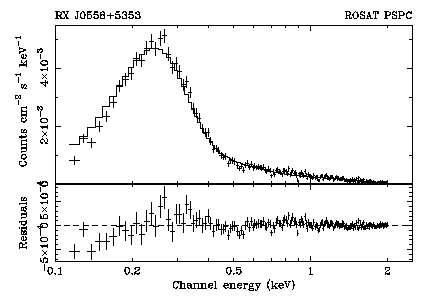
PSPC spectrum of a member (RX J0558.0+5353) of the new class of intermediate polars discovered by ROSAT
In the course of an international program to optically identify sources found in the ROSAT all-sky survey, about two dozen new cataclysmic variables (CVs) were discovered. Many of these belong to the subclass of intermediate polars (IPs), binary star systems with a magnetic white dwarf and a late-type dwarf. The X-ray flux from IPs is modulated with the rotation of the white dwarf, which is not synchronised with the orbital period as in AM Her systems. The X-ray emission from IPs known before ROSAT is in general hard, i.e. thermal bremsstrahlung with a temperature corresponding to several keV. In addition to these well known hard intermediate polars, a second class of soft intermediate polars with four members, so far, was found:
Their X-ray emission may be characterized by a two-component spectrum:

PSPC spectrum of a member (RX J0558.0+5353) of the new class of intermediate polars discovered by ROSAT
These soft intermediate polars have properties similar to AM Her type CVs: a heated polar cap, a small projected size of the emission region, circular polarization in the case of RE0751+14, a magnetic field strength at the lower end of distribution in AM Her systems, and relatively long orbital periods. Due to the weaker magnetic field they need more time to synchronize and probably play an important role as progenitors in the evolution of magnetic CVs.
Haberl F. and Motch C., New intermediate polars discovered in the ROSAT survey: two spectrally distinct classes, Astron. Astrophys. 297, L37-L40 (1995)
Get abstract from ADS service.
All rights reserved.
© Max-Planck-Institut für Extraterrestrische Physik,
Postfach 1603, 85740 Garching, Germany.